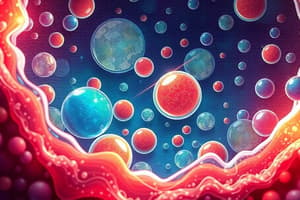Podcast
Questions and Answers
What is the function of the cytoplasm in a cell?
What is the function of the cytoplasm in a cell?
Holds organelles
What structure in the cell contains DNA?
What structure in the cell contains DNA?
Nucleus
What is the function of ribosomes?
What is the function of ribosomes?
- Transport lipids
- Produce DNA
- Store proteins
- Produce proteins (correct)
Smooth ER has attached ribosomes.
Smooth ER has attached ribosomes.
What does the Golgi apparatus do?
What does the Golgi apparatus do?
What energy molecule is produced by mitochondria?
What energy molecule is produced by mitochondria?
What do lysosomes contain that helps break down waste materials?
What do lysosomes contain that helps break down waste materials?
Which organelle is responsible for detoxifying and helping produce lipids?
Which organelle is responsible for detoxifying and helping produce lipids?
What is the function of vacuoles in plant cells?
What is the function of vacuoles in plant cells?
What is the primary function of the cell membrane?
What is the primary function of the cell membrane?
What structures are only found in plant cells and are involved in photosynthesis?
What structures are only found in plant cells and are involved in photosynthesis?
Bacteria cells do not have a defined __________.
Bacteria cells do not have a defined __________.
Flashcards are hidden until you start studying
Study Notes
Typical Animal Cell
- Cytoplasm: The watery fluid inside the cell containing organelles.
- Nucleus: The control center of the cell, containing DNA for protein synthesis.
- Ribosomes: Tiny structures that make proteins following instructions from DNA.
- Rough Endoplasmic Reticulum (Rough ER): Folded membranes with attached ribosomes, responsible for protein production and transport.
- Smooth Endoplasmic Reticulum (Smooth ER): Folded membranes without ribosomes, involved in detoxification and lipid production.
- Golgi Apparatus: Packages and modifies proteins for export or use within the cell.
- Mitochondria: Double-membrane organelles that generate energy (ATP) through cellular respiration, using glucose and oxygen.
- Lysosomes: Membrane-bound sacs containing enzymes for breaking down waste materials.
- Vacuoles: Storage compartments for various materials, often large in plant cells for water storage.
- Cell membrane: A phospholipid bilayer regulating the passage of molecules in and out of the cell, maintaining homeostasis.
Typical Plant Cell
- Chloroplasts: Double-membrane organelles found only in plant cells, containing chlorophyll for photosynthesis.
- Cell Wall: A rigid outer layer providing support and protection to the plant cell, primarily composed of cellulose.
Typical Bacteria Cell
- Cell Wall: Provides structural support and protection.
- Cell Membrane: Regulates the entry and exit of molecules.
- Cytoplasm: The fluid that fills the cell, containing organelles.
- Ribosomes: Responsible for protein synthesis.
- DNA: A circular molecule containing the cell's genetic information.
- Flagellum: A whip-like structure used for movement.
Organelles
- Endoplasmic Reticulum (ER): A network of membranes essential for protein synthesis and lipid production.
- Rough ER: Has ribosomes attached for protein production.
- Smooth ER: Lacks ribosomes and focuses on lipid production and detoxification.
- Ribosomes: The sites of protein synthesis.
- Mitochondria: The "powerhouses" of the cell, responsible for energy (ATP) production.
- Lysosomes: Membrane-bound organelles containing enzymes that break down cellular waste.
- Vacuoles: Storage compartments for various materials, often large in plant cells for water storage.
Cell Membrane Structure
- The cell membrane is a phospholipid bilayer with embedded proteins that regulate the movement of molecules in and out of the cell.
- The membrane also contains cholesterol, which helps maintain its structure.
Studying That Suits You
Use AI to generate personalized quizzes and flashcards to suit your learning preferences.




